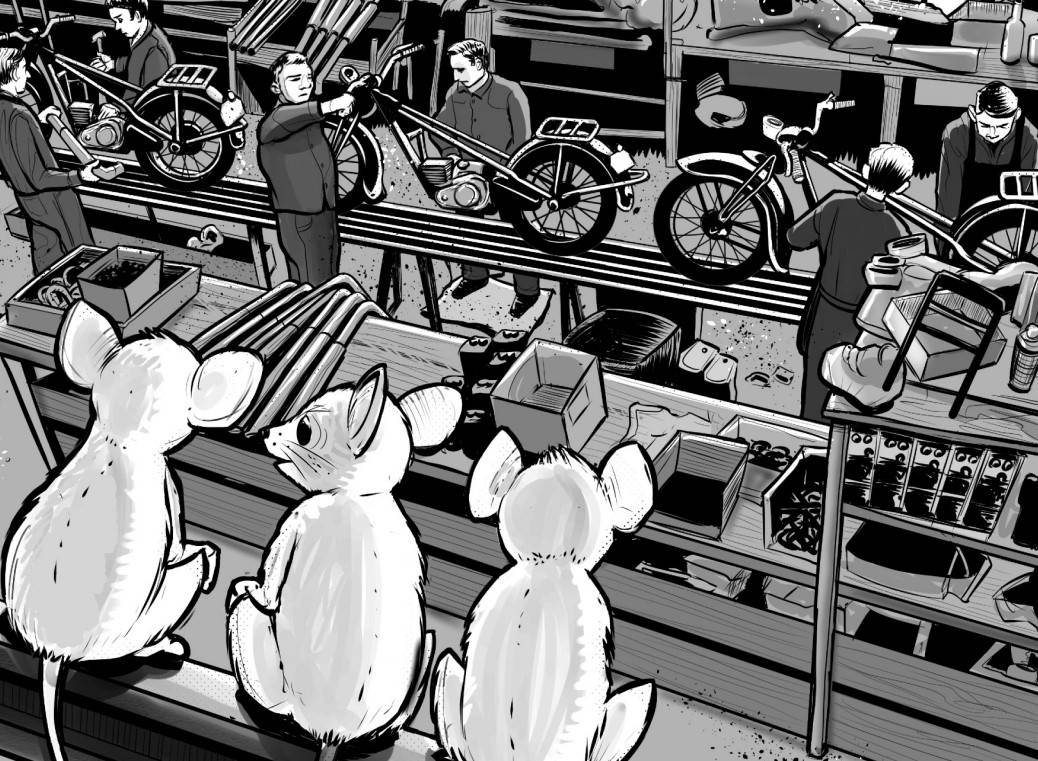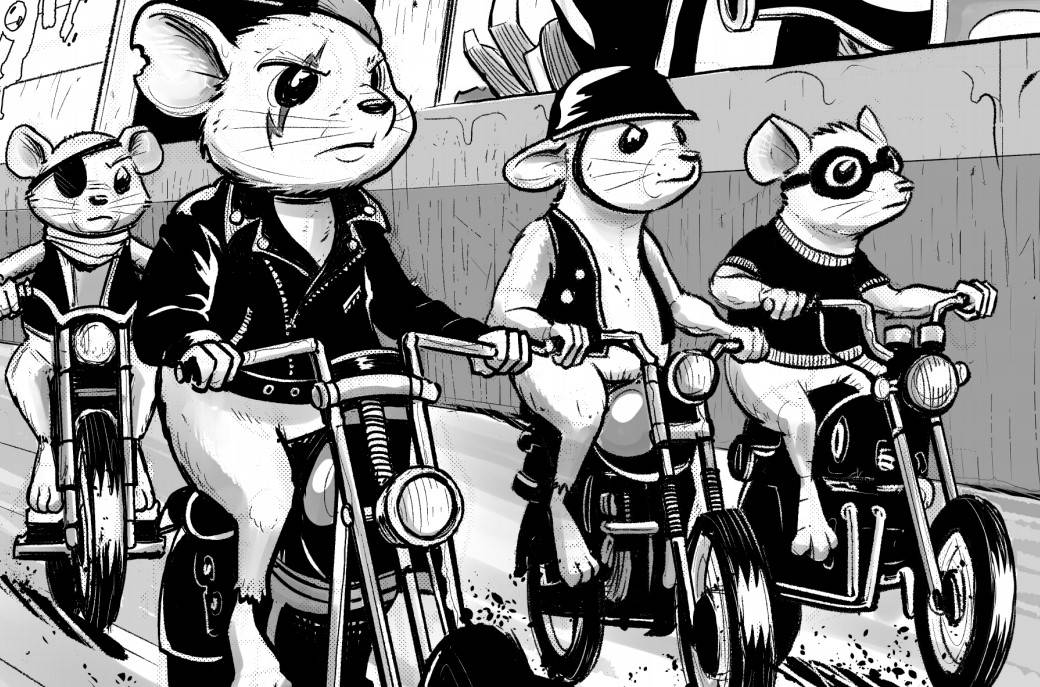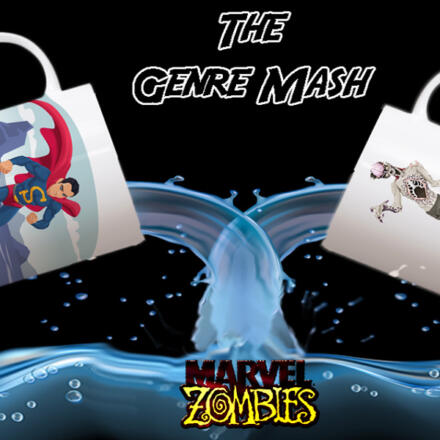
I can’t say that I ever wondered what it would be like to play Sons of Anarchy, but as mice. I can say that as soon as I saw this pitch for Heavy Metal Thunder Mouse, it didn’t take me long to back the Kickstarter, because sometimes I think crazy ideas need to be encouraged. That said, not every crazy idea makes a smooth transition to fully realized game, so let’s take a closer look at Heavy Metal Thunder Mouse, and see how it rides.
Heavy Metal Thunder Mouse is a game where you play members of a motorcycle club, in a world where humans are still perceiving everything the way they do in our world, but they aren’t quite aware of the animal societies that exist all around them. That, and mice are the only animals that figured out how to make tiny functional motorcycles.
Time for the T-CLOCKÂ
So, what does a game about mice riding motorcycles look like? Let’s find out.
The PDF of this game, which is what I utilized for this review, is 162 pages. There is an orange and purple cover, and all the interior art is black and white line art. This includes maps of the city, and full-page images of our motorcycle mice and what their world looks like. The layout itself is single column, with solid, effective fonts throughout.
There is a table of contents, but no index, and there are two pages of Kickstarter backers at the end of the book. The line art does a great job of being just cartoonish enough to sell that some mice wear clothes and ride motorcycles, but this isn’t a world of anthropomorphized animals.
There are also several examples of motorcycle club patches, both for established clubs in the setting, and patches that aren’t associated with any particular club, to serve as inspiration.
 Introduction, Contents, and Welcome to Thunder City
Introduction, Contents, and Welcome to Thunder City
This section briefly frames the concept of the game and it’s setting. The scope of the book is to introduce a single city where motorcycles were an important part of industry. The mice picked up on this and created their own motorcycles and clubs, and the city itself has seen better days.
It has a nice, concise explanation of roleplaying games, that only runs for about a paragraph and uses examples like video games, improv, and movies to make its point. I’m calling this out because in a lot of “what is roleplaying” sections, some games still explain things like they are speaking to an audience in the late 70s that has no contact with other elements of modern pop culture.
There is also a brief introduction to the Fate Core system, on which this game is based. Enough of the Core rules are presented in this book to make it a stand-alone game release.
Mice and Bikes
This section of the book details the history of the city, the motorcycle industry, and how mice started to interact with that environment. There are sections that detail various areas of the city in broad terms, as well as some of the existing motorcycle clubs in the city. The book also details what some of the other important animals are like in the city, and how they interact with mouse society, and it associates various personalities to important sections of the city.
There is also a section on customizing the game, playing with the tone of the game, and changing the Core assumptions. As a default, the game is telling the story of mice in near-modern times in a city that has seen better days, in a serious but not grim tone. There are some tips on making the tone lighter, and on drifting the setting to things like science fiction, but that advice is more cursory than detailed.
The Founding
This section is about getting ready to play the game, and covers the following topics:
- World Creation
- Character Creation
- Club Creation
While the broad strokes of the setting are already in place, world creation stresses that you decide what to include and how important various elements are. This is also when the group decides on a current issue and an impending issue for the campaign.
Character creation is going to be familiar to anyone comfortable with Fate Core, but filtered through the lens of this world, and with one other quirk–every character has the Driving skill, which can be swapped out for one of the higher rank skills to make it better to start, or can be downgraded to add more to the mouse’s bike. While many of the skills are similar to those found in Fate Core, a few have been flavored for the setting, such as Know-how, Mischief, and Snooping.
The bike gets its own stress track. It can also acquire specific bike stunts, and if the mouse character lowers their Driving skill to start, they can get one of those stunts at the beginning of the game.
The club has its own sheet to track its traits, which include things like:

- Beliefs
- Officers and Members
- Skills
- Stunts
- Stress
- Refresh
Essentially, the club is an extra that has stats, not unlike a character. The club stunts, however, are often stunts that can be accessed by members of the club, if the situation is right, and the stakes involve the entire club. Taking stress can cause a club to fall on hard times, or even disband, and gives the players a tool for tracking their efforts if they are acting directly against another club in the game.
The book advises that the club section is optional, and not as useful for one-shots or short-term campaigns.
Fate Core is a huge, broad toolkit, so what can make or break any product relying on it is how it chooses to utilize those tools. This section provides a nice example of how to tailor some of the Fate Core rules towards making certain elements important and gameable at the table.
Mice and Dice
This section presents most of the player facing Fate Core rules, as they pertain to dealing with a regular game session. Aside from the established extras in the previous section (bikes, clubs), there isn’t a lot that is different in this section compared to Fate Core.
One thing I really appreciated in this section is that it does a good job of explaining that you should make the stakes very clear at the outset of a conflict. It also does a good job of explaining that area Aspects can imply what needs to be done to move between them in a clear fashion. It felt like a very focused explanation of how to utilize the rules.
GM
This section has advice for running a campaign, and it tackles the GM facing elements of Fate Core. It also has a few sample scenarios, which are not full adventures themselves, but spell out the following for a GM to use as a template:
- Problem
- Story Questions
- Opposition
- First Scene
- The Rest
The GM section takes time to address first time GMs, and to give them some specific advice about the role they play, and not being too concerned with mastering everything, all at once. It also addresses the role of GM as host, and the social implications of this, outside of game rules and story structure.
The basic Fate Core advice is pretty solid as well. There were several times when reading this I was reminded of things I could do in my Dresden Files Accelerated game to make it a better experience.
 Reference
Reference
The reference section covers a lot of different topics, such as the following:
- Mediography
- Sample Patches
- Warm Ups
- Quick Start Reference
- Gangs of Thunder City Cards
- NPC Stats
- Random Tables
The mediography is interesting, as it covers both “small animals dealing with a human world” and “motorcycle clubs” in its suggested consumption. It also includes music, which I greatly endorse when creators are putting together inspirations for their game.
Warm Ups is interesting, as it gives a few example exercises to get into character and the right headspace for the game.
The random tables have you roll two Fate dice and consult a chart, for inspiration with the following topics:
- Motorcycle Malfunctions
- Road Obstructions
- Party Trouble
- Interpersonal Drama
- Who Shows Up?
- Where Are We Headed?
- Scene Prompts
- Who Caused This Trouble?
There is also a bigger 4dF chart of character quirks at the end. I really like this, because not only can it shake loose some creativity for a GM that is having some trouble coming up with concepts, but it also essentially provides a sample list of the kinds of things the creator expects to show up as elements in the game.
Stitching A Line Not only does the book show the core concepts of Fate Core, but it gives a good example of how to customize Fate Core to reinforce a theme with the rules for bikes and clubs.Â
The book does a great job of conveying its setting in a manner that feels less like a textbook and more like an example of how that setting is meant to be used. This is done in multiple different ways throughout the book. Tying NPCs to locations, giving example clubs, and having random lists of adventure elements are all ways that the setting’s tone and contents get reinforced. The explanation of the Fate Core rules is clear, and would be a great introduction to the game system. Not only does the book show the core concepts of Fate Core, but it gives a good example of how to customize Fate Core to reinforce a theme with the rules for bikes and clubs.
Horizontal Parking
It isn’t a bad thing, but the setting isn’t going to be for everyone. The only real criticism I can make on this front is that the book touches on story elements that are outside of its scope, but doesn’t want to make any hard determinations about them. For example, it mentions reinforcing that the scope of the game is mice interacting with other animals, at that scale, but briefly talks about engaging humans. Generally, humans are this big, insurmountable, fixed element in the story, and that’s clear, but in a few cases, the book is softer about “maybe humans could be directly engaged,” without much support for that. It might have been better to have a more definitive “you won’t ever stress out a human in a conflict, you just overcome them or challenges that they represent in different ways.”
Recommended–If the product fits in your broad area of gaming interests, you are likely to be happy with this purchase.
The product does a good job of presenting a clear setting, supporting that setting with gameable details, and utilizing the Fate Core rules to reinforce what is important to make that setting unique. If the setting doesn’t appeal to you, the implementation of Fate Core rules may still make it worth the purchase.
















